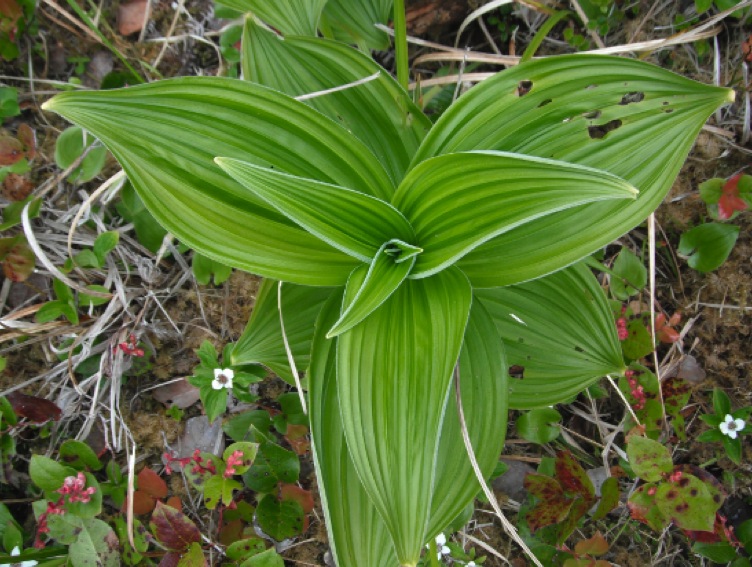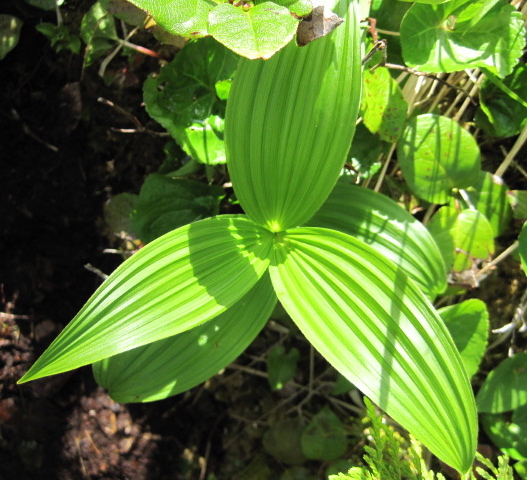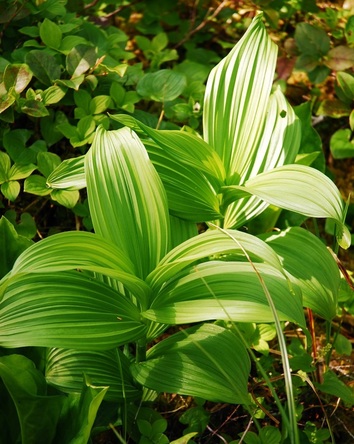Indian hellebore, green false hellebore, corn lily • Veratrum viride • Heiltsuk/Haíɫzaqv - h̓a̓úx̌vsúlí
{Vera = true, atrum = black; this may be a reference to the dark flower centres}
Identification
This perennial species has hairy unbranched stems with large (10-35 cm long) leaves. The leaves are broad, oblong-elliptic in shape with pointed ends and a clasping base. The leaves are visibly pleated and have hairy undersides. The flowers are star-shaped and grow in long and thin terminal branching clusters that tend to droop. They are light green and have dark green centres. The whole plant can be up to 2 m tall.
Habitat & Range
Indian hellebore grows in moist to wet areas such as wet meadows and forests, bogs, swamps, and streambanks. It can be found from low to alpine elevations, and is most common at subalpine elevations. It is a common species throughout most of BC except for the northeast corner of the province, and it is particularly common in the southern region. Its is found throughout much of western and eastern North America (see range map).
Similar Species
California false hellebore (Veratrum californicum) is a similar species found in Washington and Oregon. It has whitish flowers and non-drooping flower branches.
Human Uses
WARNING: Indian hellebore is extremely poisonous. Even ingesting a small amount can be lethal due to toxic steroidal alkaloids present, especially in roots, shoots, and rhizomes. Reported symptoms of poisoning include a decrease in blood pressure and heart rate, foaming at the mouth, blurred vision, loss of consciousness, lock-jaw, vomiting, and diarrhea. There have been reports of people suffering from stomach cramps after drinking water in which hellebore grows. Most coastal First Nations groups have a variety of traditional medicinal uses for this plant, such as poultices.
The chemical supply company Sigma-Aldrich details the pharmacological impacts of the steroidal alkaloids present in Indian hellebore.
Intriguing Info
Livestock tend to avoid eating Indian hellebore, and it can be fatal to those that do try it, though sheep seem to be less affected. Some species of this genus have been used to make a garden insecticide.
True hellebores belong to the genus Helleborus - hence the 'false' in green false hellebore.
iNaturalist
https://www.inaturalist.org/taxa/79484-Veratrum-viride
This perennial species has hairy unbranched stems with large (10-35 cm long) leaves. The leaves are broad, oblong-elliptic in shape with pointed ends and a clasping base. The leaves are visibly pleated and have hairy undersides. The flowers are star-shaped and grow in long and thin terminal branching clusters that tend to droop. They are light green and have dark green centres. The whole plant can be up to 2 m tall.
Habitat & Range
Indian hellebore grows in moist to wet areas such as wet meadows and forests, bogs, swamps, and streambanks. It can be found from low to alpine elevations, and is most common at subalpine elevations. It is a common species throughout most of BC except for the northeast corner of the province, and it is particularly common in the southern region. Its is found throughout much of western and eastern North America (see range map).
Similar Species
California false hellebore (Veratrum californicum) is a similar species found in Washington and Oregon. It has whitish flowers and non-drooping flower branches.
Human Uses
WARNING: Indian hellebore is extremely poisonous. Even ingesting a small amount can be lethal due to toxic steroidal alkaloids present, especially in roots, shoots, and rhizomes. Reported symptoms of poisoning include a decrease in blood pressure and heart rate, foaming at the mouth, blurred vision, loss of consciousness, lock-jaw, vomiting, and diarrhea. There have been reports of people suffering from stomach cramps after drinking water in which hellebore grows. Most coastal First Nations groups have a variety of traditional medicinal uses for this plant, such as poultices.
The chemical supply company Sigma-Aldrich details the pharmacological impacts of the steroidal alkaloids present in Indian hellebore.
Intriguing Info
Livestock tend to avoid eating Indian hellebore, and it can be fatal to those that do try it, though sheep seem to be less affected. Some species of this genus have been used to make a garden insecticide.
True hellebores belong to the genus Helleborus - hence the 'false' in green false hellebore.
iNaturalist
https://www.inaturalist.org/taxa/79484-Veratrum-viride
References
Munro, D.B. Notes on Poisoning: Veratrum viride. (2009). Canadian Poisonous Plants Information System. Canadian Biodiversity Information Facility, Government of Canada. Accessed 09/04/2014.
Pojar, J. and MacKinnon, A. (1994). Plants of Coastal British Columbia. Vancouver, BC: Lone Pine Publishing. P. 113.
Veratrum viride Aiton. In Klinkenberg, Brian. (Ed.). E-Flora BC: Electronic Atlas of the Plants of British Columbia. Lab for Advanced Spatial Analysis, Department of Geography, University of British Columbia, Vancouver. Accessed 09/04/2014.
Authors and editors of page
Kelly Fretwell, Ian Cruickshank, and Brian Starzomski (2014).
Munro, D.B. Notes on Poisoning: Veratrum viride. (2009). Canadian Poisonous Plants Information System. Canadian Biodiversity Information Facility, Government of Canada. Accessed 09/04/2014.
Pojar, J. and MacKinnon, A. (1994). Plants of Coastal British Columbia. Vancouver, BC: Lone Pine Publishing. P. 113.
Veratrum viride Aiton. In Klinkenberg, Brian. (Ed.). E-Flora BC: Electronic Atlas of the Plants of British Columbia. Lab for Advanced Spatial Analysis, Department of Geography, University of British Columbia, Vancouver. Accessed 09/04/2014.
Authors and editors of page
Kelly Fretwell, Ian Cruickshank, and Brian Starzomski (2014).







